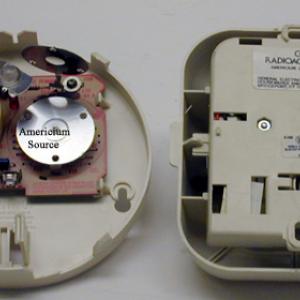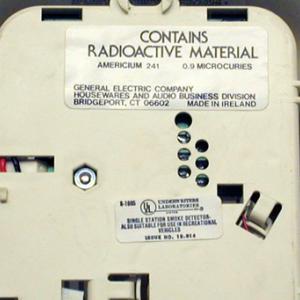College of Liberal Arts & Sciences
7D30.45 - Smoke Detector
Open up the smoke detector and pass it around and show that the active element is composed of Americium 241. The Geiger counter may be used to detect the radiation coming off of the source. These are alphas so they won't travel a great distance.
A point of interest is that Americium 241 has a half-life of 432.2 years. So, as long as you put batteries in your smoke detector regularly, it should last for several lifetimes.
- Lawrence Ruby and John Hunt, "Understanding Modern Electrical Protective Devices", TPT, Vol. 35, #7, Oct. 1997, p. 432.
- Jack G. Gouch and Kelly L. Vaughn, "Radioactive Consumer Products in the Classroom", TPT, Vol. 33, #1, Jan. 1995, p. 18.
- H. Richard Crane, "Ionization Smoke Alarms", TPT, Vol. 22, #8, Nov. 1984, p. 526 - 528.
- J. R. Young, "The Smoke Detector", TPT, Vol. 17, #7, Oct. 1979, p. 467.
- Curt Suplee, "Inner sanctum", Everyday Science Explained, National Geographic, p. 126.
- Borislaw Bilash II, “Actinide Elements are Useful“, A Demo A Day – A Year of Physical Science Demonstrations, p. 139.
Disclaimer: These demonstrations are provided only for illustrative use by persons affiliated with The University of Iowa and only under the direction of a trained instructor or physicist. The University of Iowa is not responsible for demonstrations performed by those using their own equipment or who choose to use this reference material for their own purpose. The demonstrations included here are within the public domain and can be found in materials contained in libraries, bookstores, and through electronic sources. Performing all or any portion of any of these demonstrations, with or without revisions not depicted here entails inherent risks. These risks include, without limitation, bodily injury (and possibly death), including risks to health that may be temporary or permanent and that may exacerbate a pre-existing medical condition; and property loss or damage. Anyone performing any part of these demonstrations, even with revisions, knowingly and voluntarily assumes all risks associated with them.

